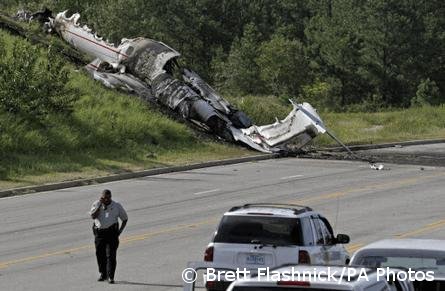A proposed airworthiness directive (AD) set to be published tomorrow suggests that under-inflated tires may have initiated the chain of events that led to the rejected takeoff crash of a Learjet 60 crash in Columbia, South Carolina on 19 September 2008, killing four of the six onboard.
According to the US National Transportation Safety Board’s preliminary report, issued in October, information on the aircraft's cockpit voice recorder revealed that the crew initiated the rejected takeoff after hearing a "sound consistent with a tire failure" at 136kt (252km/h), just after the V1 callout, the speed beyond which pilots are generally instructed to take off rather than attempt to stop on the remaining runway.

The business jet continued past the 305m (1,000ft) runway safety area, hit airport lighting, navigation facilities, a perimeter fence and concrete marker posts before crossing a roadway and coming to rest on an embankment and burning, the NTSB determined.
In the AD to be published tomorrow, the FAA reveals that all four of the aircraft’s main tires appear to have blown out, which could have also played a role in the NTSB’s finding that at least one of the Learjet’s two engines thrust reversers had not deployed during the full-power rejected takeoff attempt. Though the FAA does not identify the particular accident, details provided link it to the Columbia crash, the only Learjet 60 hull loss in NTSB records since 2004.
“We received a report of all four of the main landing gear tires blowing out during a takeoff roll of a Learjet Model 60 airplane,” writes the FAA in the proposed AD. “The airplane overran the end of the runway, ultimately stopping when it struck an embankment, and was destroyed by fire.”
Additionally, FAA says that investigation of tire fragments “indicates that, in all four tires, there was evidence of internal heat damage consistent with under-inflation, over-loading, or a combination of both; damage to a tire under these conditions is cumulative” and that “tires that have been rolled or taxied at lower-than-specified tire pressure settings may fail”.
The regulator says it is proposing the AD “to prevent tire failure, which could result in failures of the braking and thrust reverser systems. In a critical phase of operation such as takeoff, loss of airplane control may result”.
If approved as written, the AD will require operators to include procedures for the aircraft’s flight and maintenance manuals to use when checking for and maintaining proper tire inflation. Public comments on the proposal are due by mid-July.
Source: FlightGlobal.com























